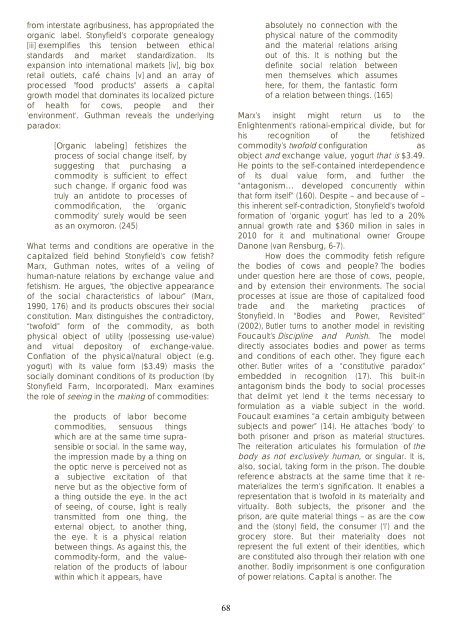Marketing Animals - Antennae The Journal of Nature in Visual Culture
Marketing Animals - Antennae The Journal of Nature in Visual Culture
Marketing Animals - Antennae The Journal of Nature in Visual Culture
You also want an ePaper? Increase the reach of your titles
YUMPU automatically turns print PDFs into web optimized ePapers that Google loves.
from <strong>in</strong>terstate agribus<strong>in</strong>ess, has appropriated the<br />
organic label. Stonyfield’s corporate genealogy<br />
[iii] exemplifies this tension between ethical<br />
standards and market standardization. Its<br />
expansion <strong>in</strong>to <strong>in</strong>ternational markets [iv], big box<br />
retail outlets, café cha<strong>in</strong>s [v] and an array <strong>of</strong><br />
processed "food products" asserts a capital<br />
growth model that dom<strong>in</strong>ates its localized picture<br />
<strong>of</strong> health for cows, people and their<br />
'environment'. Guthman reveals the underly<strong>in</strong>g<br />
paradox:<br />
[Organic label<strong>in</strong>g] fetishizes the<br />
process <strong>of</strong> social change itself, by<br />
suggest<strong>in</strong>g that purchas<strong>in</strong>g a<br />
commodity is sufficient to effect<br />
such change. If organic food was<br />
truly an antidote to processes <strong>of</strong><br />
commodification, the ‘organic<br />
commodity’ surely would be seen<br />
as an oxymoron. (245)<br />
What terms and conditions are operative <strong>in</strong> the<br />
capitalized field beh<strong>in</strong>d Stonyfield’s cow fetish?<br />
Marx, Guthman notes, writes <strong>of</strong> a veil<strong>in</strong>g <strong>of</strong><br />
human-nature relations by exchange value and<br />
fetishism. He argues, "the objective appearance<br />
<strong>of</strong> the social characteristics <strong>of</strong> labour” (Marx,<br />
1990, 176) and its products obscures their social<br />
constitution. Marx dist<strong>in</strong>guishes the contradictory,<br />
“tw<strong>of</strong>old” form <strong>of</strong> the commodity, as both<br />
physical object <strong>of</strong> utility (possess<strong>in</strong>g use-value)<br />
and virtual depository <strong>of</strong> exchange-value.<br />
Conflation <strong>of</strong> the physical/natural object (e.g.<br />
yogurt) with its value form ($3.49) masks the<br />
socially dom<strong>in</strong>ant conditions <strong>of</strong> its production (by<br />
Stonyfield Farm, Incorporated). Marx exam<strong>in</strong>es<br />
the role <strong>of</strong> see<strong>in</strong>g <strong>in</strong> the mak<strong>in</strong>g <strong>of</strong> commodities:<br />
the products <strong>of</strong> labor become<br />
commodities, sensuous th<strong>in</strong>gs<br />
which are at the same time suprasensible<br />
or social. In the same way,<br />
the impression made by a th<strong>in</strong>g on<br />
the optic nerve is perceived not as<br />
a subjective excitation <strong>of</strong> that<br />
nerve but as the objective form <strong>of</strong><br />
a th<strong>in</strong>g outside the eye. In the act<br />
<strong>of</strong> see<strong>in</strong>g, <strong>of</strong> course, light is really<br />
transmitted from one th<strong>in</strong>g, the<br />
external object, to another th<strong>in</strong>g,<br />
the eye. It is a physical relation<br />
between th<strong>in</strong>gs. As aga<strong>in</strong>st this, the<br />
commodity-form, and the valuerelation<br />
<strong>of</strong> the products <strong>of</strong> labour<br />
with<strong>in</strong> which it appears, have<br />
68<br />
absolutely no connection with the<br />
physical nature <strong>of</strong> the commodity<br />
and the material relations aris<strong>in</strong>g<br />
out <strong>of</strong> this. It is noth<strong>in</strong>g but the<br />
def<strong>in</strong>ite social relation between<br />
men themselves which assumes<br />
here, for them, the fantastic form<br />
<strong>of</strong> a relation between th<strong>in</strong>gs. (165)<br />
Marx’s <strong>in</strong>sight might return us to the<br />
Enlightenment's rational-empirical divide, but for<br />
his recognition <strong>of</strong> the fetishized<br />
commodity’s tw<strong>of</strong>old configuration as<br />
object and exchange value, yogurt that is $3.49.<br />
He po<strong>in</strong>ts to the self-conta<strong>in</strong>ed <strong>in</strong>terdependence<br />
<strong>of</strong> its dual value form, and further the<br />
“antagonism… developed concurrently with<strong>in</strong><br />
that form itself” (160). Despite – and because <strong>of</strong> –<br />
this <strong>in</strong>herent self-contradiction, Stonyfield’s tw<strong>of</strong>old<br />
formation <strong>of</strong> ‘organic yogurt’ has led to a 20%<br />
annual growth rate and $360 million <strong>in</strong> sales <strong>in</strong><br />
2010 for it and mult<strong>in</strong>ational owner Groupe<br />
Danone (van Rensburg, 6-7).<br />
How does the commodity fetish refigure<br />
the bodies <strong>of</strong> cows and people? <strong>The</strong> bodies<br />
under question here are those <strong>of</strong> cows, people,<br />
and by extension their environments. <strong>The</strong> social<br />
processes at issue are those <strong>of</strong> capitalized food<br />
trade and the market<strong>in</strong>g practices <strong>of</strong><br />
Stonyfield. In “Bodies and Power, Revisited”<br />
(2002), Butler turns to another model <strong>in</strong> revisit<strong>in</strong>g<br />
Foucault’s Discipl<strong>in</strong>e and Punish. <strong>The</strong> model<br />
directly associates bodies and power as terms<br />
and conditions <strong>of</strong> each other. <strong>The</strong>y figure each<br />
other. Butler writes <strong>of</strong> a “constitutive paradox”<br />
embedded <strong>in</strong> recognition (17). This built-<strong>in</strong><br />
antagonism b<strong>in</strong>ds the body to social processes<br />
that delimit yet lend it the terms necessary to<br />
formulation as a viable subject <strong>in</strong> the world.<br />
Foucault exam<strong>in</strong>es “a certa<strong>in</strong> ambiguity between<br />
subjects and power” (14). He attaches ‘body’ to<br />
both prisoner and prison as material structures.<br />
<strong>The</strong> reiteration articulates his formulation <strong>of</strong> the<br />
body as not exclusively human, or s<strong>in</strong>gular. It is,<br />
also, social, tak<strong>in</strong>g form <strong>in</strong> the prison. <strong>The</strong> double<br />
reference abstracts at the same time that it rematerializes<br />
the term’s signification. It enables a<br />
representation that is tw<strong>of</strong>old <strong>in</strong> its materiality and<br />
virtuality. Both subjects, the prisoner and the<br />
prison, are quite material th<strong>in</strong>gs – as are the cow<br />
and the (stony) field, the consumer (‘I’) and the<br />
grocery store. But their materiality does not<br />
represent the full extent <strong>of</strong> their identities, which<br />
are constituted also through their relation with one<br />
another. Bodily imprisonment is one configuration<br />
<strong>of</strong> power relations. Capital is another. <strong>The</strong>












